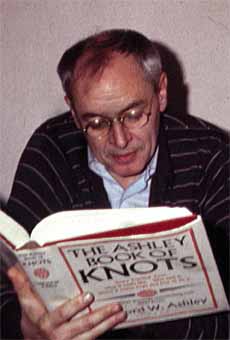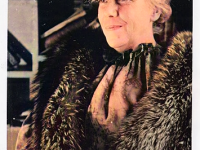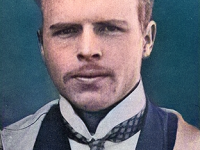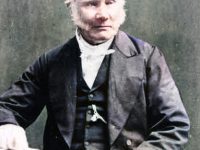
R.D. Laing. Photo: Robert E. Haraldsen [No machine-readable author provided. Profero assumed (based on copyright claims)., CC BY-SA 3.0, via Wikimedia Commons]
On August 23, 1989, Scottish psychiatrist Ronald David Laing passed away. Laing is noted for his alternative approach to the treatment of schizophrenia. His first book, The Divided Self, was an attempt to explain schizophrenia by using existentialist philosophy to vividly portray the inner world of a schizophrenic, which Laing presented as an attempt to live in an unlivable situation. Laing’s views on the causes and treatment of serious mental dysfunction, greatly influenced by existential philosophy, ran counter to the psychiatric orthodoxy of the day by taking the expressed feelings of the individual patient or client as valid descriptions of lived experience rather than simply as symptoms of some separate or underlying disorder.
Education and Studies
Ronald David Laing was born in the Govanhill district of Glasgow, Scotland, on 7 October 1927, the only child of civil engineer David Park MacNair Laing and Amelia Glen Laing (née Kirkwood). He studied medicine at Glasgow University from 1945 to 1951. There he developed a special interest in psychotic patients. Inspired by reading Harry Stack Sullivan, Frieda Fromm-Reichmann and Marguerite Sechehaye, he sought an understanding approach to these patients. Next to his formal studies, Laing also continued his philosophical education, especially phenomenology and existentialism. In the early 1950s, Laing moved his enthusiasm towards neurology and psychiatry and he worked for 6 months at the West of Scotland Neurosurgical Unit in nearby Killearn. The position was followed by a two-year post as psychiatrist at the British Army as part of the Royal Army Medical Corps. There, it is believed, Laing found an interest in communicating with mentally distressed people.
R.D. Laing became the youngest consultant in the country at the Glasgow Royal Mental Hospital. It has been suggested that the Glasgow approach to mental illness, and many of Laing’s ideas, were influenced by the work of David Henderson, who in turn credited the American Adolf Meyer. In 1956, at the Tavistock Institute in London, R. D. Laing went on to train on a grant. The institute was widely known as a centre for the study and practice of psychotherapy. He began training as a psychoanalyst at the Institute of Psychoanalysis (his teaching analyst was Charles Rycroft under the supervision of Donald W. Winnicott and Marion Milner). In disappointment and critical departure from this experience, he turned to the analytical psychology of Carl Gustav Jung‘s, whose thinking seems to permit the rehabilitation of psychotic processes as a meaningful, mental restructuring (“metanoia”).[4]
Laing’s critical examination of psychiatric theory
Like Ludwig Binswanger, the founder of “Daseinsanalyse”, before him, Laing was inspired in his critical examination of psychiatric theory and practice by the insights of recent German (Husserl, Heidegger) and French philosophy (Sartre), from which he expected a changed view of the phenomena of serious mental disorders. In 1960 The Divided Self was published. Referring back to the contemporary philosophical movement of phenomenology and existential philosophy, Laing drew a first summary of his engagement with conventional psychiatry and psychoanalysis. On the basis of a phenomenological ontology of interpersonal relationship (interpersonal phenomenology), he criticized in particular its objectifying, depersonalizing character and the resulting medical practice. Interpersonal phenomenology is intended to be a method of describing what is going on between people, largely without any medical interpretation or ideology (such as psychoanalysis or current psychiatric school opinion). For the medical practice Laing demands a phenomenological attitude, which is expressed in the willingness to meet people directly and the ability to renounce the distribution of roles typical of the situation.
Thus, Laing became known as an important figure in the anti-psychiatry movement, along with David Cooper. Challenging psychiatric diagnosis itself, Laing argued that diagnosis of a mental disorder contradicted accepted medical procedure: diagnosis was made on the basis of behavior or conduct, and examination and ancillary tests that traditionally precede the diagnosis of viable pathologies occurred after the diagnosis of mental disorder. Hence, according to Laing, psychiatry was founded on a false epistemology: illness diagnosed by conduct, but treated biologically.
The treatment of Schizophrenia
R.D. Laing believed that schizophrenia was “a theory not a fact”. According to the psychiatrist, the models of genetically inherited schizophrenia being promoted by biologically based psychiatry were not accepted by leading medical geneticists. Further, according to Laing, diagnosis of mental illness did not follow a traditional medical model, which probably led him to question the use of medication such as antipsychotics by psychiatry. His entire work is directed against the reification of psychotic diseases, which Freud [5] regarded as untreatable. For Laing, these mental disorders also stand in the context of a genesis – family and social – and are above all existential situations of the affected persons themselves, which must be lived by them and experienced by the doctors in charge etc. and, if at all possible, should be existentially understood rather than objectively categorized.
The experience of the schizoid or schizophrenic, according to Laing, is characterized by the feeling of being constantly threatened, which he calls “ontological insecurity”, and to distinguish it from the experience basis of other persons:
“If a position of primary ontological security has been reached, ordinary living conditions do not represent a permanent threat to one’s existence. If such a basis of life has not been achieved, the usual situations of daily life pose a continuous and deadly threat. Only when you understand this is it possible to understand how certain psychoses can develop.”
— R. D. Laing, The divided self (1960)
The permanent fear of destruction manifests itself as fear of devouring, implosion (destructive penetration of reality into the self) or petrification (petrification by terror) and depersonalization.
Later Life
In 1965 Laing founded the Philadelphia Association, whose goal is to save the mentally ill from being admitted to a psychiatric institution by living together in a supervised household. One of the first projects was a shared flat in Kingsley Hall, a house in London, where Laing and other members of the Philadelphia Association lived together with schizophrenics (documentary film Asylum by Peter Robinson, USA 1972). In the 1960s he worked with the mathematician, psychologist and philosopher George Spencer-Brown, who became known in Germany primarily through Niklas Luhmann. Laing is one of the few scientists to explicitly refer to Spencer-Browns Laws Of Form.
In 1989 R. D. Laing died of a heart attack while playing tennis in St. Tropez.
Ronald D Laing and Leo Matos: Transpersonal Psychology 1982 [7]
References and Further Reading:
- [1] R.D. Laing Biography at the Laing Society
- [2] R.D. Laing at Britannica
- [3] R.D. Laing at Famous Psychologists
- [4] The Undiscovered Self – C. G. Jung and Analytical Psychology, SciHi Blog
- [5] Sigmund Freud’s Structural Model of the Human Psyche, SciHi Blog
- [6] R. D. Laing at Wikidata
- [7] Ronald D Laing and Leo Matos: Transpersonal Psychology 1982, A lecture given by Ronald D Laing (1927-1989) and Leo Matos February 10 1982 as a St Görans Lecture in Stockholm. Introduction by Prof Lennart Wetterberg. PsychiatryLectures @ youtube
- [8] R. D. Laing”, in The New Left, edited by Maurice Cranston, The Library Press, 1971, pp. 179-208.
- [9] Miller, Russell (12 April 2009), “RD Laing: The abominable family man”, The Sunday Times, London.
- [10] “R.D. Laing; Guru of ’60s Counterculture”. Los Angeles Times. 25 August 1989.
- [11] Laing, R.D. (1965). The Divided Self. Pelican.
- [12] Boyers, R. and R. Orrill, Eds. (1971) Laing and Anti-Psychiatry. New York: Salamagundi Press.
- [13] Burston, D. (1996) The Wing of Madness: The Life and Work of R. D. Laing. Cambridge, MA: Harvard University Press.
- [14] Timeline for R. D. Laing, via Wikidata





